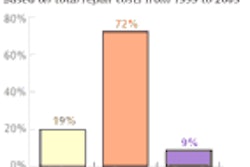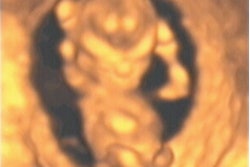U.S. researchers found that contrast-enhanced 3-D power Doppler confers additional diagnostic power over standard 2-D and 3-D power Doppler in breast cancer imaging, while a Turkish group found contrast-enhanced power Doppler to be effective only in patients with suspicious lesions, according to separate articles published in the February issue of the Journal of Ultrasound in Medicine.
To compare mammography with contrast-enhanced 2-D and 3-D power Doppler imaging for breast cancer diagnosis, researchers from Thomas Jefferson University Hospital in Philadelphia studied 55 patients who had received breast biopsies with histopathological assessment (JUM, February 2004, Vol. 24:2, pp.173-182).
Of the 55 patients, 22 received Levovist (Berlex Laboratories, Wayne, NJ), and 33 received Optison (Mallinckrodt, Hazelwood, MO). Both pre-contrast and post-contrast 2-D power Doppler data of the lesion were obtained using an HDI 3000 scanner (Philips Medical Systems, Andover, MA), with 3-D data acquired using an LIS 6000A system (Life Imaging Systems, London, Ontario, Canada).
Two independent readers assessed the diagnosis, blinded to the histopathological results. Receiver operating characteristics (ROC) curves were computed individually and in combination for mammography and 2-D and 3-D ultrasound (both pre-and post-contrast). The researchers also compared histopathologic and imaging parameters using Mann-Whitney statistics.
Standard 2-D power Doppler produced sensitivity of 73% and a specificity of 58% among the 55 patients, while 3-D power Doppler yielded sensitivity of 75% and specificity of 36%. Adding contrast enhancement boosted 3-D sensitivity to 88% and specificity to 41%, the researchers found.
Mammography had sensitivity of 100% and specificity of 41%. While the differences in specificity among the modalities were not statistically significant, mammography’s superior sensitivity may have been due to the high number of subjects with calcifications (46%), the study team said.
Three-dimensional power Doppler imaging was significantly more sensitive than 2-D power Doppler (p=0.046). Also, contrast-enhanced 3-D ultrasound performed better than baseline 3-D (p=0.008) and 2-D power Doppler scanning (p=0.018), as well as grayscale studies (p=0.039), according to the researchers.
The study team also found that the area under the ROC curve for breast cancer diagnosis was significantly higher for contrast-enhanced 3-D power Doppler imaging (0.76) than for 2-D imaging with contrast enhancement (0.55) and without (0.66), as well as for 3-D power Doppler imaging without contrast enhancement (0.60).
The researchers said they were somewhat surprised to find that the area under the ROC curve for 2-D power Doppler imaging was significantly higher without contrast enhancement than with contrast (p =0.026). Mammography yielded an area of 0.86, which was significantly higher than all of the ultrasound modalities, except for contrast-enhanced 3-D power Doppler (p=0.16).
While most comparisons between the sonographic results and the histopathologic variables were not significant, the presence or absence of anastomoses assessed with contrast-enhanced 3-D power Doppler imaging correlated significantly with the pathologic diagnosis of benign or malignant breast tumors (p =0.007), the researchers reported.
"This indicates that the chaotic morphologic structure of tumor neovascularity can be evaluated with 3-D contrast-enhanced imaging," the authors wrote. "Moreover, linear regression showed that contrast-enhanced 2-D and 3-D assessments of anastomoses correlated (r2 = 0.47; p = 0.002), which suggests that the added dimensionality of 3D imaging is an important factor."
The researchers also discovered that the pathologist’s diagnosis of a benign or malignant lesion correlated with the degree of vascularity seen on 3-D contrast-enhanced imaging (p= 0.02), showing the synergistic effect of combining 3-D power Doppler imaging with a sonographic contrast agent.
"Although the assessment of both anastomoses and the degree of vascularity made by 2-D and 3-D contrast-enhanced imaging correlated (p < 0.003), only the latter provided a marker for malignancy; that is, the pathologic diagnosis of benign or malignant breast tumors correlated significantly with contrast-enhanced 3-D power Doppler assessments of anastomoses and vascularity (p < 0.02)," the researchers wrote. "This indicates that the chaotic morphologic structure of tumor neovascularity can be evaluated better with contrast-enhanced 3-D power Doppler imaging than with the corresponding 2-D technique."
In other findings, 3-D contrast-enhanced signals were more likely to be deemed acceptable (i.e., mild to excellent enhancement) than 2-D contrast-enhanced signals (86% vs. 75%; p = 0.01).
"In this study the use of contrast-enhanced 3-D power Doppler imaging for breast cancer diagnosis has been shown to provide statistically significant improvements compared with conventional 2-D and 3-D sonography, albeit based on a relatively small patient population," the researchers wrote. "Furthermore, mammography combined with sonographic imaging was better than mammography alone in this limited study. Finally, it appears that contrast-enhanced 3-D power Doppler imaging may provide a marker for malignancy, but further studies are required to confirm these results."
Effect on differential diagnosis
In another JUM article, researchers from the University Hospital of Gazi in Ankara, Turkey, evaluated the usefulness of contrast-enhanced power Doppler ultrasound on the differential diagnosis of breast lesions after a combination of mammography and grayscale ultrasound (JUM, February 2004, Vol. 24:2, pp.183-195)
The study team performed power Doppler ultrasound on 68 patients with 69 breast masses before and after injection of contrast (Levovist) using a 6-to-13-MHz transducer on a Logiq 500 scanner (GE Medical Systems, Waukesha, WI). Lesions were diagnosed as "highly suggestive of malignancy" (category 5, n=32), "suspicious" (category 4, n=21), and "probably benign" (category 3, n=16).
The categories were modeled on the BI-RADS classification system. Using subjective evaluation, the authors examined the estimated area of vascularity, degree of enhancement following contrast agent administration, morphologic features, and distribution of vessels within the lesions.
The researchers detected significant enhancement after contrast agent injection in both the malignant (28 lesions) and benign groups (41 lesions). Only two criteria -- estimated area of vascularity and degree of enhancement following contrast agent administration --proved to be significant diagnostic determinants for contrast-enhanced power Doppler sonography (p<0.001; interobserver agreements, 74.4 and 77.8, respectively), the authors wrote.
While contrast-enhanced power Doppler sonography provided higher specificity, positive predictive value, and negative predictive value than power Doppler sonography without contrast, it also produced a lower sensitivity and negative predictive value than mammography/grayscale sonography. The exception was for category 4 lesions, for which the combination of mammography, grayscale sonography, and contrast-enhanced power Doppler sonography yielded a higher specificity (71%) and positive predictive value (70%) than the duo of mammography and grayscale sonography (39% and 53%, respectively).
Only in the category 4 lesions could the combination of mammography/grayscale sonography and contrast-enhanced power Doppler sonography accomplish a higher specificity (71%) and positive predictive value (70%) than mammography/grayscale sonography (39% and 53%, respectively). However, its use in this category of lesions comes with drawbacks, including imperfectly established criteria, lack of absolute certainty, and high cost, the researchers said.
The authors concluded that the highest accuracy in the diagnosis of breast lesions on the basis of power Doppler and contrast-enhanced power Doppler can be accomplished only when these tests are used together with a complete mammographic and sonographic evaluation.
"It is certain that (power Doppler) and (contrast-enhanced power Doppler) cannot be recommended as confirmatory tests in BI-RADS category 3 and category 5 lesions, and although (contrast-enhanced power Doppler) may help reduce the number of unnecessary biopsies in BI-RADS category 4 lesions, recommendation of its use has many drawbacks," the authors write. "A better understanding of the enhancement kinetics and improvements in ultrasound technology may change the current indications for contrast agent use in the breast."
By Erik L. RidleyAuntMinnie.com staff writer
February 27, 2004
Related Reading
Affordable equipment accelerates ultrasound proliferation, January 26, 2004
Frost predicts tripling of non-mammo breast imaging in U.S., December 9, 2003
Breast ultrasound experts share pearls and pitfalls, October 2, 2003
Making the most of breast sonography with the right equipment, techniques, August 25, 2003
Copyright © 2004 AuntMinnie.com




















